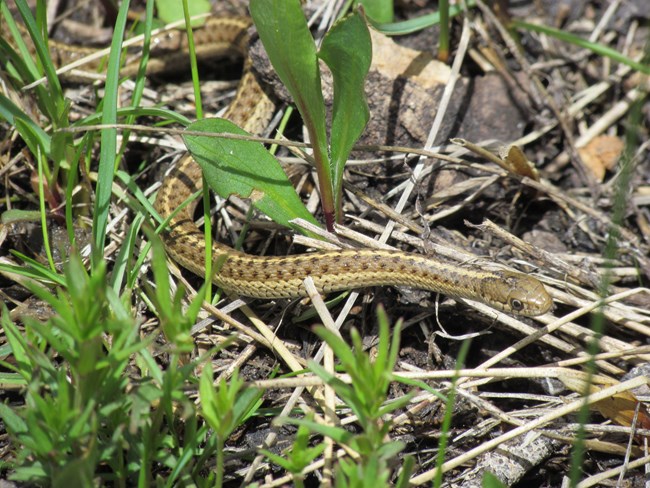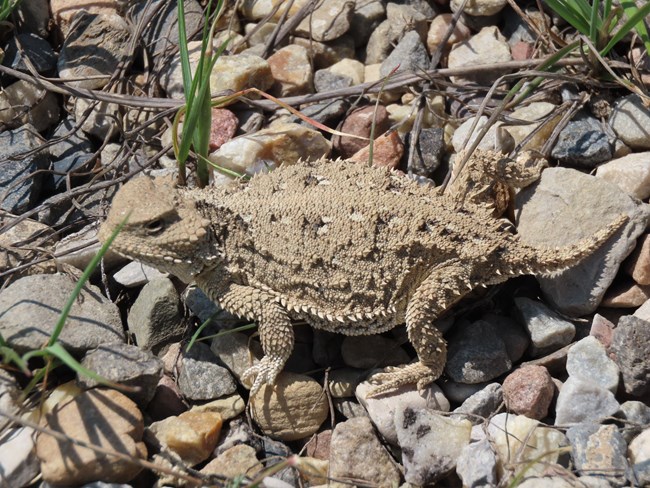|
The wandering garter snake (Thamnophis elegans vagrans) and greater short-horned lizard (Phrynosoma hernandesi) are the only reptiles found within the park. The monument's sagebrush steppe landscape appears to be ideal habitat for rattlesnakes, so why are they not found here? Prairie rattlesnakes inhabit other parts of Wyoming at elevations over 8,500 feet, but usually are restricted to elevations less than 7,000 feet (the Fossil Butte visitor center is at 6,775 feet). More research is necessary to discover why they do not live here at Fossil Butte National Monument. Check out our fossil reptiles. 
NPS photo Wandering Garter Snake (Thamnophis elegans vagrans)This snake is found all the way from Canada to Baja California and from California to the western edges of South Dakota, Nebraska, and Oklahoma. They can be found throughout the park. At low elevations they are frequently seen along the edges of streams and ponds while at higher elevations they may be more common on rocky cliffs and slopes formed from rocky debris (talus). Adults reach lengths of 16-43 inches. Their diet consists of small prey such as frogs, lizards, worms, and rodents. Although they do use venom to capture their prey, it is not considered dangerous to humans as it causes only mild irritation. 
NPS photo Eastern Short-Horned Lizard (Phrynosoma hernandesi)The name Phrynosoma is Greek for toad bodied. These lizards are often called "horned toads," after the small spikes and horns that cover their bodies. These spikes are part of a defense mechanism: they puff up their bodies, extending the spikes and making themselves more difficult to grab and swallow. They are also known for ocular-sinus blood squirting (shooting blood from the eye) when threatened by a canine. It is a Species of Greatest Conservation Need (SGCN) by the Wyoming Game and Fish Department (WGFD). The horned toad was adopted as the Wyoming State Reptile in 1993. ReferencesSherbrooke, Wade, George Middendorf, and C. Guyer. "Blood-Squirting Variability in Horned Lizards (Phrynosoma)." Copeia 2001(4):1114-1122. DOI:10.1643/0045-8511(2001)001[1114:BSVIHL]2.0.CO;2"Terrestrial Gartersnake — Thamnophis elegans." Montana Field Guide. Montana Natural Heritage Program and Montana Fish, Wildlife and Parks. Accessed on February 24, 2024. https://FieldGuide.mt.gov/speciesDetail.aspx?elcode=aradb36050 Whitaker, Jake. "Thamnophis elegans Western Terrestrial Garter Snake." Animal Diversity Web, 2014. https://animaldiversity.org/accounts/Thamnophis_elegans/ "Wyoming Species of Greatest Conservation Need." Wyoming State Wildlife Action Plan - 2017. Wyoming Game and Fish Department. Accessed on February 29, 2024. https://wgfd.wyo.gov/WGFD/media/content/PDF/Habitat/SWAP/SGCN-Introduction.pdf |
Last updated: March 27, 2024
